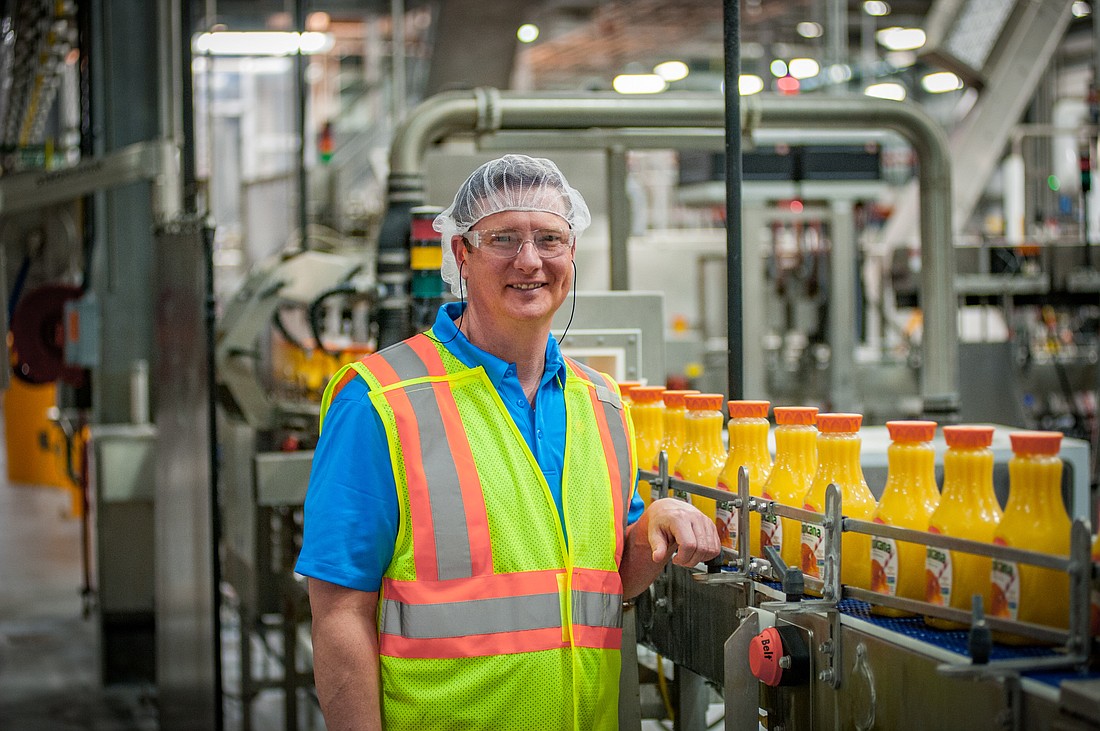- April 21, 2025
-
-
Loading

Loading

One of the main sources of Tropicana orange juice — one of the most widely recognized orange juice brands in the world — comes from a plant in Bradenton.
But for the most part that facility, which, along with a smaller plant in Fort Pierce service all of North America with Tropicana OJ, does its work relatively out of the way. While mostly closed off, a recent peek behind the scenes, during a plant tour for Florida Recycling Partnership members, reveals one of the area’s most prolific manufacturing ventures. The processes, explained by Bradenton Plant Director Cliff McDerment, reveal precise attention to detail and a focus on the final product — good guidelines for any business.
The staggering operation, on 285 acres, with 69 acres under roof, includes about 7,000 square feet of cold storage space. The plant processes 200 to 300 trucks a day, and each truck is filled with about 150,000 oranges. Annually, the plant processes about 4 billion oranges.
The first step for fruit arriving at the plant is receiving and processing. Most growers delivering fruit to the plant are from central Florida.
Oranges are emptied from the trucks and then washed. The Florida Department of Agriculture does testing on site of the oranges, and it will reject loads that don’t meet certain criteria, says McDerment.
Before the fruit is squeezed for juice, the company harvests orange oil by removing it from the peel. It sells the oil to perfume companies and distillers. Some peel oil is also used for flavoring, orange cleaners and other products.
Once the oil is extracted, orange peels are turned into flakes, mixed with molasses and made into cattle feed. The process that turns the peel into feed involves dehydrating it, and that process, McDerment says, is what people smell when they drive by the plant. The feed goes by rail car to the Port of Tampa, where it’s exported, mostly to Europe where there isn’t as much room to grow feed. None of the orange itself, he says, goes to the landfill.
After the oranges are cut in half, they go through extractors. Each extractor handles 12 oranges per second before screens separate the juice.
The plant hums with activity 24 hours a day, five to six days a week and sometimes seven days a week, McDerment says. “If growers need us to run, we run,” he says. The main idea: “Be available for our growers when their crops are ready.”
There are 865 people working on site. Factoring in employees who work in Tropicana offices across the street from the production plant in transportation, logistics and other areas, the number rises to almost 1,000 people.
Before being bottled, orange juice is stored inside a large building at the plant that’s kept at 35 degrees. The building houses carbon steel tanks that have ceramic coatings inside. The tanks hold chilled orange juice, with a motor agitating the juice. Tanks have a capacity of 1 million gallons, and in total, the building can store 63.5 million gallons of orange juice.
“If growers need us to run, we run.” — Cliff McDerment, Bradenton plant director, Tropicana
Tropicana blows its own bottles on site. When the company makes containers themselves, it can control the quality, McDerment says. After bottles are filled with the product and dried, the container is labeled.
Cameras on the production line look for perfect products — and any imperfections, such as a label that’s askew. McDerment says Tropicana officials are big on the concept of the perfect consumer experience.
The plant, along with PepsiCo, Tropicana’s owner, have embarked on a mission to become more sustainable. Over the last two years, McDerment says the plant lowered the amount of waste going into landfills by 50%. The costs savings of the reduction are hard to quantify, company officials say, but the sustainability efforts will continue.
Around the plant, scrap metal bins collect materials to be recycled. The plant is also home to train tracks that speak to another environmental effort. Three trucks can fit into a single railcar, McDerment says, so by using trains to move product, Tropicana is able to get more trucks off the roads.
Running an operation to fuel consumers’ orange juice desires remains front of mind at the plant. With trains chugging, assembly lines humming and trucks full of oranges rolling, Tropicana’s Bradenton plant plays a key role in keeping glasses full of OJ year round.